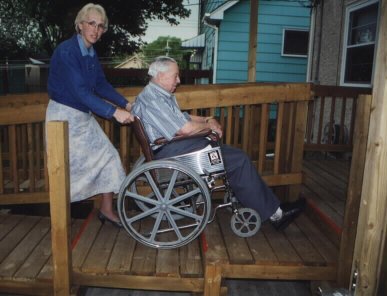Modular stairs and ramps relieve
walking woes

Be it ever so humble . . .
there’s no place like home.
So why do so many people
have trouble getting into and out of their own front doors?
One reason is that
(according to the U.S. Department of Housing and Urban Development (HUD)) fewer
than one in 10 homes in the U.S. is designed to accommodate people with mobility
limitations.
“That’s why modular stairs
and ramps may be the key to home accessibility for many people,” says Bob
Zimmerman, an independent living counselor with the Minnesota Division of
Rehabilitation Services in St. Paul.
The modular design
recommended by Zimmerman was developed in 1992 by a professional engineer. It is
suitable for people with a permanent or short-term need for a ramp or steps, can
be built offsite in sections, installed quickly, used for as long as needed, and
then be easily removed and used again at another site.
Zimmerman also specializes
in helping to connect people with the financial and labor resources needed for
construction of the accessibility projects.
In several cases, people
have been able to save on labor fees by recruiting volunteers. An average-length
ramp can be built by a group of three or four people with basic carpentry skills
in about two days.
For example, in February
1998, the Home Ramp Project in Maryland enlisted the services of five
volunteers, including a few board members of the Corporation for Assistive
Technology. Even drizzling rain and temperatures below 40-degrees could not
dampen the builders’ pride in the finished 30-foot ramp.
A step-by-step manual titled
How to Build Ramps for Home Accessibility is available from the Metropolitan
Center for Independent Living (MCIL) in St. Paul, Minnesota (see details at end
of this article). The manual includes complete information on how to build a
ramp or steps using MCIL designs.
Need Financial
Assistance?
Even if costly medical bills
have you in a financial bind, you still have options. Get in touch with your
county’s human services office for eligibility-based medical assistance, or your
state’s housing finance agency, for information regarding lenders. Inquire with
your municipal government regarding community development block grants for
federal funding. The specific names of contact departments or offices and
eligibility requirements, if any, will vary from state to state.
You can also contact clubs
or fraternal organizations that do volunteer work or fundraising projects in
your community. Veterans may qualify for money from the Veterans’ Administration
and should contact a veterans’ service officer for information. You may also get
assistance regarding your specific needs from a Center for Independent Living in
your area.
Although at this time it is
not a routinely covered addition to a home, call your insurance representative
to see if your condition may merit assistance for ramp or steps installation.
Ramp or
Steps?
Although a ramp is necessary
for wheelchair access, Zimmerman has found that long tread, low-riser steps are
often more useful for lower extremity amputees. “I think the most important
aspect of the steps is that most people find them easier than ramps to walk on,”
he says.
Many people with mobility
impairments may continue to struggle with standard steps or have a ramp
installed simply because they don’t know about long-tread low-riser steps.
Anyone who is able to walk, especially people with lower limb loss, a walker, a
cane or crutches, may benefit from the steps.
Experiences
Rosemary
Connelly

Over 150 people in the
Minneapolis/St. Paul area have chosen the long-tread low-riser steps, including
Rosemary Connelly of St. Paul, Minn., a 63-year-old, right below knee amputee.
“I can’t even describe how
happy I am with my steps. They’re absolutely terrific!” she told InMotion.
Connelly had thought about getting a ramp, but decided the steps would better
suit her needs. She has had her steps for almost a year without any problems.
Ankle movement is limited
for lower extremity amputees, Connelly notes. This can pose a problem when there
is a slope on walking surfaces—but the steps are level. “My balance is
absolutely fantastic,” she says. “I have perfect leverage!”
She also controls her own
momentum when walking down the steps because she is not fighting gravity
traveling up and down. She carries packages without any difficulty and can
maneuver as quickly, or as slowly, as she wants.
“Neighbors said ‘Oh, you got
a new deck,’” Connelly laughs. “It helps your feel better about it.” The curves
and angles incorporated in some step designs look more like an expression of
aesthetic flare than an accessibility aid.
Connelly’s husband says that
he no longer worries when his wife goes up and down the steps by herself. Mr.
Connelly, a volunteer at a VA hospital and a self-proclaimed, experienced
wheelchair pusher, also says that when his wife does need a wheelchair, he has
no problems helping her up and down the long-tread, low-riser steps.
Often, people who have some
walking ability still need to use a wheelchair part of the time. While the steps
are not intended for independent wheelchair use, someone tilting the chair from
behind and then rolling it to the next step can assist a person in a wheelchair
up and down the steps.
Marjorie
Herrmann

Connelly shared her
experience using steps with Marjorie Herrmann, who had lost her right leg above
the knee. Hermann felt frustrated and helpless as she watched Connelly walk into
her hospital room with relative ease. She refused to believe that Connelly was
indeed missing a leg, until Connelly took off her prosthesis and showed her
stump.
Herrmann said talking with
Connelly gave her hope that she, too, could walk again. When Zimmerman visited
her to explain how the stairs worked she was thoroughly confused. “I thought, ‘I
can’t go up and down stairs,’” Herrmann told InMotion. She was worried about
being able to live alone productively and comfortably and had them installed in
hopes that they might help. Herrmann now walks up and down her steps with only a
cane and recommends the steps to anyone who has trouble on even slight inclines
like driveways.
Rick
Reller

Rick Reller lost both of his
legs below the knee and had steps installed four months after his amputation. A
woman in a wheelchair temporarily had used the steps before Reller, and he had
them relocated when she no longer needed them. Zimmerman says Reller saved about
$600-$700 on materials alone by relocating already-built steps.
“They helped tremendously
with access into my home,” Reller says. He carries all kinds of things up and
down his steps with no problem, from groceries and books for college to his dog
Taylor, on a leash or in his arms. If Reller does need a wheelchair for some
reason, he says assistance up and down the steps is easy, even considering his
six-foot stature.
He praises the accommodating
height of the riser and generous length of the tread and says he has never had
any maintenance difficulties. In fact, Zimmerman reports that in his five years
of installing ramps, he has never had any problems with shifting or movement;
durability is not an issue.
Reller’s elderly neighbor
says standard steps are difficult, and finds the low riser steps easier to use.
Lower-extremity amputees find the steps accommodating, but Zimmerman stresses
that any older person with less strength and energy than in their younger days
may find the steps helpful, as well as people with muscular dystrophy,
arthritis, emphysema or other health-related conditions.
Michel
Andreotti

“Everyone with leg problems
could benefit from steps,” says Michel Andreotti of St. Paul, Minn., who has had
his set for two years. Forty-six-year-old Andreotti is a bilateral B/K who lost
his legs because of diabetes.
Andreotti goes to dialysis
three times a week and picks up his wife from work, and his steps provide him
with the means to come and go as he pleases. “Anyone with a double amputation
should have them—especially if they want independence,” he says.
Besides creating a shorter
distance to walk using less energy and helping with balance, the steps keep
Andreotti’s gait straight. If someone was to drive down his street and see him
walking down the steps, Andreotti says that they would not be able to tell that
he was an amputee.
Winter’s ice and snow are
little threat when using the steps, Andreotti says. They are shoveled easily
and, even with a thin coat of ice, they do not have the slope that can be
hazardous on a ramp. Sturdy handrails and a narrower width are optional, which
can help with stability by using your hands and arms.
Other Tips
Before you start building a
ramp or steps, carefully consider your situation to determine the best choice
for accessibility.
• Try stepping up and down a
low curb or step between parallel bars with your therapist to see if steps are a
good option.
• Try walking on a sloped
surface to see if a ramp might be a better choice.
A building permit may be
needed for your ramp building project. Contact the building code office for your
community to find out the details. Telephone numbers should be listed in the
Government section of the phone book under Building Inspection, or call the
administrative office for direction.
• Take a manual or copies of
the relevant pages with you when talking with local building officials.
Individual manual pages can be printed from the web site quite easily.
• When speaking with local
building code officials, be sure to inform them if the ramp will be temporary or
permanent because this may have a bearing on whether or not a building permit is
needed.
Your home should be a
comfortable retreat, not a confining source of aggravation. You make every
effort to ensure that visiting friends and family are comfortable when they come
for a visit. Now it’s your turn. Consider a modular ramp or set of steps to make
your home as accessible as possible.
The How to Build Ramps
for Home Accessibility manual is available on-line for reprinting at WheelchairRamp.org. To purchase a printed
copy of the 63-page construction guide or the video for $20 each (price subject to change), contact the
Metropolitan Center for Independent Living at (651) 646-8342. You may also write
the MCIL at 1600 University Ave. W., Suite 16, St. Paul, MN
55104-3825.
Building for
Convenience
The Department of Housing
and Urban Development (HUD) offers a 60-page report filled with valuable
information and strategies for those working to make home modifications, and the
universal design principles they embody.
HUD has also published
Residential Remodeling and Universal Design: Making Homes More Comfortable
and Accessible, a guidebook for the housing professional or the
do-it-yourselfer. You may browse these and other titles on line at http://www.huduser.org/, or call
800-245-2691.
The Center for Universal
Design, a part of the School of Design at North Carolina State University in
Raleigh, specializes in promoting accessibility and a universal design in
buildings. Research, training, technical assistance, referrals and other
information are available to individuals. People interested in universal design
can obtain publications, videos and other resources. For more information, call
800-647-6777 or (919) 515-3082, or log on to The Center’s Web site at www.design.ncsu.edu/cud.
 DVD Excerpt:
DVD Excerpt:





